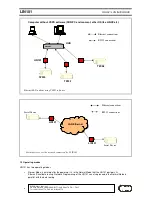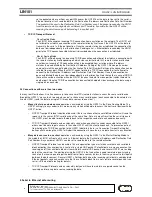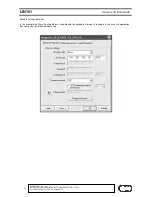
LIN101
RS232 / LAN INTERFACE
ELPRO Video Labs s.r.l.
Via della Praia 4/a FERRIERA di BUTTIGLIERA ALTA (TO) - ITALY
Tel. +39 0119348778 - FAX +39 0119348779
8
so the packet can be sent from any port. Whenever the LIN101 has the data to transmit in the serial ->
Ethernet direction it will send the data to the Destination IP-address and Destination Data Port Number.
The packet will be sent to the Destination Data Port Number even if the packet received by the LIN101
from the remote station originated at a different port. Therefore, it possible that the LIN101 will be
receiving the data from one port but sending it to another port!
•
TCP/IP Transport Protocol
o
Slave Routing Mode.
The LIN101 will accept an incoming TCP connection from any station on the network. The LIN101 will
not attempt to establish a connection with a remote station by itself even it the LIN101 has the data to
transmit in the serial -> Ethernet direction. Once the remote station has established the connection the
data can flow independently in either direction. Pending serial -> Ethernet data received by the LIN101
prior to the TCP connection establishment is discarded when the connection is established.
o
Master Routing Mode.
The LIN101 will both accept an incoming TCP/IP connection and attempt to establish a connection with
the remote station by itself depending on which side sends that data first- remote station or attached
serial device. Incoming TCP connection will only be accepted from a station whose IP-address
matches the one defined by the Destination IP-address Setting of the LIN101. Source port number
need not match the one defined by the Destination Data Port Number Setting so the connection can be
initiated from any port. When the LIN101 needs to initiate a TCP/IP connection the it will attempt to
connect to the Destination IP-address and Destination Data Port Number. Once the connection has
been established the data can flow independently in either direction. Note that unlike in case of UDP/IP
there will never be a situation when the LIN101 receives the data from one port but sends the data to
another port. Once the TCP/IP connection has been established both sides exchange the data using a
single port on each side.
3.4 Connections with more than two nodes
In many real-life situations it is often necessary to have several PCs (network stations) access the same serial device
through the LIN101 (“many clients to one data source”) or have many serial devices (each connected to the network via
its own LIN101) send the data to a single PC (“many data sources to one client”).
•
Many clients to one data source
operation is achieved by using the LIN101 in the Slave Routing Mode. The
LIN101 will reply to any sender in this mode, so any station will be able to access the host serial device with the
LIN101 inside.
o
UDP/IP Transport Protocol should not be used if there is a chance that several different clients will send the
requests to the same LIN101/serial device at the same time. Data mix up will result on the serial side and
the LIN101 won’t be able to route the data back to the respective sender of each command correctly.
o
TCP/IP Transport Protocol can be used safely since when one client is already connected to the LIN101
others won’t be able to gain access to the same LIN101 until this client disconnects. To prevent one client
from holding the TCP/IP connection to the LIN101 indefinitely there is a Connection Timeout Setting that
defines after how long the LIN101 will abort the connection in case there is no data transfer in any direction.
•
Many data sources to one client
operation is achieved by using the LIN101 in the Master Routing Mode. In
this mode the LIN101 will route all its serial -> Ethernet data to the Destination IP-address and Destination Data
Port Number. Any number of LIN101s can be set to send the data to the same destination.
o
UDP/IP Transport Protocol can be used in this arrangement but you must make sure that each serial data
block output by the serial device is sent out in a single UDP packet. Potential data mix up can occur on the
receiving end if the serial data block is transmitted in several UDP packets and several LIN101 are sending
data at the same time. The upside of using the UDP/IP is that you will only need to maintain one listening
socket on the receiving end to get the data from all data sources (unless, of course, you want to distinguish
between the data sources). Several LIN101’s Settings define how the incoming serial data is combined into
Ethernet packets so you can make sure that the serial data block from is not split into several packets (see
serial -> Ethernet data routing for details).
o
TCP/IP Transport Protocol can be used safely but you will have to maintain a separate socket on the
receiving end for every data source sending the data.
4 Serial to Ethernet data routing





































